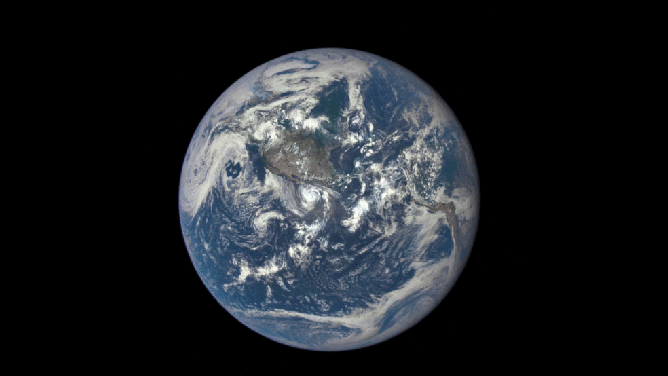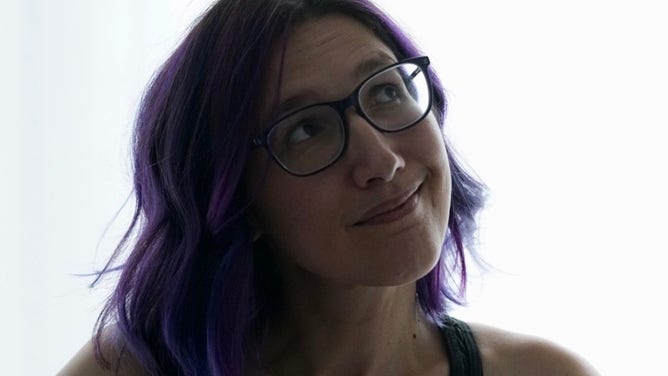Making 'Moonfall': Scientists play disaster muses adding science to sci-fi
Mike McKinnon is a geophysicist and disaster researcher who consults on science-fiction entertainment.

This animation features actual satellite images of the far side of the moon, illuminated by the sun, as it crosses between the DSCOVR spacecraft and the Earth - one million miles away. (Credits: NASA/NOAA)
Earth's only moon is staying put, and it's not going to come crashing into our planet, but what if it did? That's what scientists had to answer for the movie "Moonfall."
The movie came out Feb. 4 and starred Halle Berry, Patrick Wilson and John Bradley, who will be well known to any "Game of Thrones" fans.
To avoid any spoilers, a brief synopsis of the plot is that the moon has changed its orbit of Earth, and things start to unravel for our home planet as the moon gets closer and closer. That's where geophysicist and disaster researcher Mika McKinnon comes in.
"Every project uses science consultants in different ways, and I've done everything from help do world-building for a pilot that's never made air, all the way through to being the stunt handwriting for actors," McKinnon said of science consulting for Hollywood. "We were pretty much like the plausibility muses. So there were a lot of science consultants, and it was like a giant game of improvisation of ‘OK, what happens next?’"
McKinnon has been consulting in the film industry ever since "Stargate," when a show-runner came to the University of British Columbia looking for someone to help on the television show.
She said she is used to being the only scientist on a project, but for "Moonfall," the credits include former NASA astronauts, medical doctors, astronomers, astrophysics and more. There is a lot of science behind creating a fictional global disaster.
McKinnon's job was to explain the geophysics of what would happen if the moon changed its orbit.

Mika McKinnon is a geophysicist and disaster researcher who provides science consulting on TV and film projects.
To show the moon getting more prominent, the team used computer models to show what would happen in terms of its distance to Earth, showing how quickly it would appear bigger and change its angle.
"All of that was its actual real science. We don't have a way to make the moon come closer to us, but if it did, this is what it would look like," McKinnon said.
Anytime something sparked some curiosity with the movie producers, the science consultants would go down a rabbit hole, exploring the idea further.
"My job was almost to be an interactive Wikipedia … those Wikipedia rabbit holes where you click the link, and you read the article, and then you click another link," McKinnon said. "It was like that. I'd say a thing. And they go, ‘Oh, follow up on that? Tell us more.’"
There is a line in the movie about how the "moon rang like a bell." McKinnon explains that the line comes from the seismic stations placed on the moon during the Apollo missions.
"We did all sorts of things to create vibration sources, and in geophysics slang, we say it ‘rang like a bell' that the vibrations traveled through the moon, and we were able to say, ‘OK for the vibrations of travel this far, this quickly this must be what happening underground.’"
The thousands of satellites in low-Earth orbit would also be impacted if the moon changed its trajectory.
"We've got so many satellites in orbit around the Earth that are in this beautiful gravitational dance. But when something is in orbit, it's effectively falling at just the right distance at just the right speed to fall around the Earth. But if you have the moon coming closer and changing that gravitational balance, then those satellites are no longer in that perfect balance, and they start crashing into the atmosphere and burning up."
No character explains it in the movie, but when satellites begin falling, burning up in Earth's atmosphere, it's an example of the moon's real cause and effect.
McKinnon provided the geophysics expertise about what our planet would be experiencing and when it would happen. One of those events was creating a tidal wave, which McKinnon explains is like "nails on a chalkboard" when someone incorrectly calls a tsunami a tidal wave. It's a major faux pas in the disaster science field.
In "Moonfall," the tides are getting more significant as the moon gets closer, causing the tides to become more destructive by flooding cities and eventually creating an actual tidal wave.
And when it becomes apparent to the public that something isn't right, as a disaster researcher, McKinnon provided insight into how humans respond to a global catastrophe of this scale.
Scientists aren't just used in sci-fi entertainment. From comic books to romantic comedies, McKinnon said science just sort of slips in along the edges.
For example, the next time you're watching an animated show or movie, look at the food.
"When the dad is sitting there drinking an amber-colored liquid while looking exasperated, it is very different light and optical effects going on than when the baby has a bottle of opaque white liquid," McKinnon explains. "There are different optics and fluid dynamics and physics involved in milk versus a scotch. So it doesn't need to be explicit to be there and to be interesting."
"Moonfall" was filmed in 2020 during the peak of the COVID-19 pandemic. Even though it was a movie about a horrible disaster, McKinnon said it gave her a little hope during a dark time in the world.
"I felt like I got a little break from the burnout and from doing the constant risk assessments and trying to figure out how to go through my day," she said. "I went, you know, 'It's OK, we still have to have something that's over the top ludicrously disastrous, with all the same problems we're facing now with like a lack of coherent, unified action and selfishness causing more problems and all of the issues. And yet everything works out in the end."
Because it could always be worse, the moon could be crashing into Earth – but it won't.